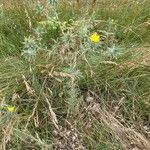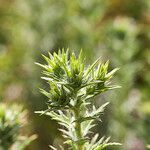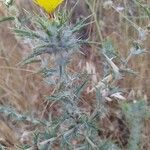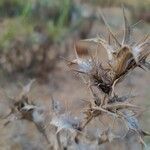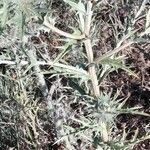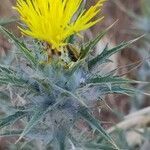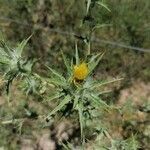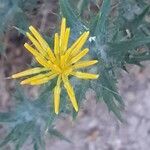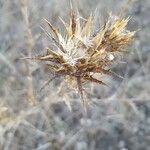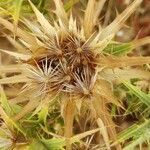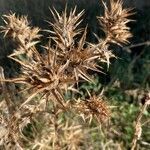Plants 40–180 cm, herbag. ± densely glandular, loosely cobwebby to ± woolly. Stems rigidly erect, openly branched distally, stramineous. Leaves basal and cauline; basal often absent at anthesis, petioles winged, blades 10–15 cm, margins pinnately 1–2-divided into linear or lanceolate spine-tipped lobes; cauline spreading or recurved, lanceolate to ovate, rigid, clasping, 3–7-veined from base, margins with narrow spine-tipped lobes, spinose-acuminate. Involucres ovoid, body 25–35 mm, usually ± tomentose. Outer phyllaries ascending or ± spreading, 35–50 mm, usually not more than 1.5 times as long as inner, terminal appendages spreading to ascending, linear-lanceolate, spiny lobed, prominently spine-tipped. Corollas yellow, sometimes red-or black-veined, 25–35 mm, throats gradually expanded; anthers yellow; pollen yellow. Cypselae brown, 4–6 mm, the outer roughened; pappus scales 1–13 mm. 2n = 44.
Herb to 1.3 m high. Stems yellowish to straw-coloured, thinly to densely pilose with mixed arachnoid and crisped multicellular hairs, and yellow to white glandular hairs to 0.15 mm long. Leaves pinnatilobed, green above and below; ±sessile glands present on both surfaces; marginal spines 3–8 mm long, yellow to brown distally. Capitula solitary, terminal on 5–25 cm long branches; involucre ovoid, 15–20 mm diam. at anthesis excluding patent bracts; outer involucral bracts 1.2–1.8 times length of inner; median bracts suberect, 22–33 mm long, 4–7 mm wide at base, with margins entire or spinose and apex spinose, glandular. Corolla yellow; tube 19–24 mm long; lobes 5–6.5 mm long. Anthers 5–5.5 mm long. Achenes obpyramidal, 4.5–5.7 mm long, grey to brown. Pappus bristles 93–123, longest ones 6.5–11 mm long.
Annual herb, up to ± 0.3 m high; branched; with glandular indumentum. Leaves alternate, pinnatifid to pinnatisect with spiny margins. Capitula discoid, solitary; involucral bracts in many rows, imbricate, spiny, outer leaf-like, inner sometimes with apical appendages. Florets all bisexual; corolla yellow. Anthers with filaments usually densely bearded. Pappus usually double, outer row of subulate, serrulate-ciliate, persistent scales, inner row with scales shorter and basally connate. Cypselae obovoid to broadly obconical, 4-angled, smooth, glabrous, with apical rim; cypselae in outer florets generally rugose.
An annual plant. It grows 80 cm high and spreads 50 cm wide. The stem is erect and stiff. The leaves are divided into lobes along the stalk. They are spiny at the edges. The flowers are yellow and like a thistle flower.
